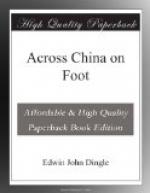As I was thus gently in soliloquy, I first heard and then caught sight of the river below—the unnavigable Salwen, 2,000 feet lower than either the Mekong or the Shweli (which we were to cross two days later). It is a pity the Salwen was not preserved as the boundary between Burma and China.
Gradually, as we approached the steep stone steps leading down thereto, I saw one of the cleverest pieces of native engineering in Asia—the double suspension bridge which here spans the Salwen, the only one I had seen in my trip across the Empire. The first span, some 240 feet by 36 feet, reaches from the natural rock, down which a vertical path zigzags to the foot, and the second span then runs over to the busy little town of Lu-chiang-pa.
Here, then, were we in the most dreaded spot in Western China! If you stay a night in this Valley, rumor says, you go to bed for the last time; Chinese are afraid of it, Europeans dare not linger in it. Malaria stalks abroad for her victims, and snatches everyone who dallies in his journey to the topside mountain village of Feng-shui-ling. The river is 2,000 feet above the sea; Feng-shui-ling is nearly 9,000 feet.
It was ten o’clock as I pulled over my stool and took tea in the crowded shop at Lu-chiang-pa. I saw Shans here for the first time.
The village now, however, is anything but a Shan village. Of the people in the immediate vicinity I counted only ten typical Shans, and of the company around me in this popular tea-house twenty-one out of twenty-eight were Chinese, including ten Mohammedans. It was, however, easy to see that several of these were of Shan extraction, who, although they had features distinctly un-Chinese, had adopted the Chinese language and custom. A party of Tibetans were here in the charge of a Lama, in an inner court, and scampered off as I rose to snap their photographs. This was a very low altitude for Tibetans to reach.
Whilst I sipped my tea the local horse dealer wanted so very much to sell me a pony cheap. He offered it for forty taels, I offered him five. It was gone in the back, was blind in the left eye, and was at least seventeen years old. The man smiled as I refused to buy, and told me that my knowledge of horse-flesh was wonderful.
The road then led up to a plain, where paths branched in many directions to the hills. Men either going to the market or coming from it leaned on their loads to rest under enormous banyans and to watch me as I passed. Horses browsed on the hill-sides. One of my soldiers had laid in provisions for the day, and ran along with his gun (muzzle forward) over one shoulder and four lengths of sugar-cane over the other. Ploughmen with their buffaloes halted in the muddy fields to gaze admiringly upon me; women ran scared from the path when my pony let out at a casual passer-by who tickled him with a thin bamboo. Maidenhair ferns grew in great profusion, showing that we were getting into warmer climate; streams rushed swiftly under the stone roadway from dyked-up dams to facilitate the irrigation, at which the Chinese are such past-masters. All was smiling and warm and bright, dispelling in one’s mind all sense of gloom, and breeding an optimistic outlook.




